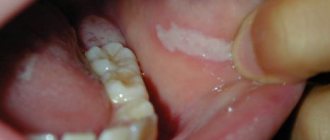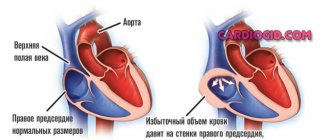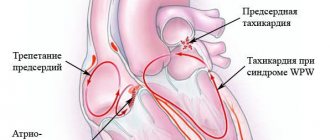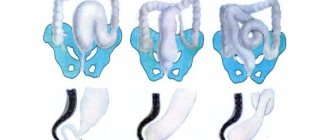Dyslalia in children is distortion or omission of sounds with normal hearing and the absence of pathologies. There are several types of disease:
- Mechanical – caused by pathologies of the organs of the articulatory apparatus.
- Functional – caused by a child’s imitation of an adult’s incorrect speech (tongue-tied, lisping, etc.) or disturbances in the cerebral cortex.
- Monomorphic - a violation of the pronunciation of sounds from one group (S-Z-C or Sh-Zh-Ch).
- Polymorphic – violation of the pronunciation of sounds from different groups (S-R-K-SH).
Causes
The cause of the development of mechanical dyslalia is organic defects in the anatomical structure of the peripheral articulatory apparatus, which includes: jaws, teeth, lips and tongue.
Among the anomalies of the articulation apparatus leading to dyslalia, the most common are:
- short frenulum of the tongue or upper lip;
- macroglossia - massive, tongue;
- microglossia - narrow, small tongue;
- thick, inactive lips;
- malocclusion: deep, cross, open;
- anomalies of the dentition: diastemas, sparsely located or small;
- high narrow or low flat upper palate.
Anatomical defects that cause mechanical dyslalia can be congenital or occur as a result of diseases and injuries of the dental system.
With functional dyslalia, the structure of the articulatory apparatus is not changed, i.e., there is no organic basis for the violation of sound pronunciation.
In this case, the causes of dyslalia are social or biological factors:
- pedagogical neglect;
- "lisping" of adults when talking to children;
- tongue-tied, hasty speech of others;
- bilingualism in the environment;
- minimal brain dysfunction;
- general physical weakness.
Prevalence of the problem
The disease is a common occurrence, most common in the practice of speech therapists.
According to various estimates, the average number of children with such problems in preschool age is 25-30%, in elementary grades – 17-20%, and in older age – 1%. Classes with a speech therapist are also required for adults who have suffered strokes, TBI, or multiple sclerosis. Most often, there are combined disorders of sound pronunciation that prevent further mastery of written speech. At the same time, the vocabulary can be replenished according to age, all cases are used correctly, the structure of syllable formation is not disrupted, speech is developed at a high level.
Symptoms
Four types of sound pronunciation defects in dyslalia: omissions, substitutions, confusion and distortion of sounds.
By skipping a sound we mean its complete loss in one position or another: at the beginning, in the middle or at the end of a word.
Sound replacement is a persistent replacement of one sound with another, also present in the phonetic system of the native language. Sound substitutions are caused by the failure to distinguish phonemes based on subtle articulatory or acoustic features. With dyslalia, sounds can be replaced that differ in place of articulation or method of formation, on the basis of sonority-voicelessness or hardness-softness.
They talk about mixing sounds if two correctly pronounced sounds are constantly confused in the speech stream, that is, their use is either appropriate or inappropriate.
Distortion of sounds is an irregular pronunciation, the use in speech of sounds that are absent in the phonetic system of the Russian language. For example, velar or uvular pronunciation [r], interdental or lateral pronunciation [s] and others. Distortion of sounds is usually found in mechanical dyslalia.
With functional dyslalia, as a rule, the pronunciation of one or more sounds is impaired; in the case of mechanical dyslalia - a group of sounds similar in articulation. Thus, an open anterior bite will contribute to the interdental reproduction of the sounds of anterior lingual articulation [z], [s], [ts], [h], [zh], [sh], [sch], [d], [t], [l ], [n], because the tip of the tongue cannot be held behind the front teeth.
Prerequisites for functional dyslalia
This type develops due to the abnormal mental or physical state of the child. Often this diagnosis is made to children experiencing problems with mental development. In this case, the structure of the speech apparatus does not suffer, hearing is normal, and the innervation of the muscles responsible for articulation is not impaired. In children with the speech problem under consideration, the structure of the peripheral speech apparatus is normal, the innervation of the articulatory muscles is not impaired. There are two types of factors that cause this type of dyslalia.
Biological background
This group of factors includes:
- delayed psycho-speech development;
- somatic diseases;
- infectious diseases suffered during the period of active speech development;
- chronic diseases;
- hypovitaminosis;
- nutritional disorders (dystrophy).
These disorders affect neurodynamics, which is responsible for the differentiation of the speech-hearing apparatus and the speech-motor analyzer. With this manifestation, articulatory movements are not accurate enough, and speech kinesthesia may be observed.
Social preconditions
This group of factors includes:
- improper speech education;
- parents copying babbling words;
- consolidation in speech of incorrect sound pronunciation on the part of adults (burr, lisp, dialect).
During the period of speech development, a child may find himself in a bilingual environment, which can also lead to the development of dyslalia. In this case, the pronunciation rules of one language apply to the other.
Pathogenesis
Functional dyslalia is associated with an imbalance and weak dynamics of the nervous processes occurring in the child’s brain. The cortical areas do not have pronounced pathologies, but there is insufficient coordination between speech excitation and inhibition. The nature of the speech disorder is determined by the localization of the neurodynamic disorder in the subcortical region of the brain. If the entire speech department is affected, motor failure occurs, the pronunciation of individual phonemes suffers, and, secondarily, speech hearing.
If the localization is in the sensory zone (Wernicke's center), defects in sound perception primarily appear, which leads to expressive speech. This is how phonemes are mixed and replaced.
Social prerequisites for functional dyslalia
Social preconditions are those associated with adults. These include:
- parents may lisp;
- parents often make mistakes in their speech;
- being in a bilingual environment;
- they do not study enough and pay little attention to it (pedagogical neglect);
- reduced differentiation of hissing and whistling sounds;
- delays in mental development.
All these reasons can be eliminated if appropriate correctional work is carried out by speech therapists, psychologists, and parents.
Diagnostics
A speech therapist examines the structure and mobility of the organs of the articulatory apparatus through visual inspection and using special test exercises.
In the process of a speech therapy examination, the nature of the disorder is revealed, namely the absence, replacement, mixing and distortion of sounds in various positions - in isolation, in open, closed or consonant syllables, words at the beginning, middle or end, as well as phrases and texts.
Then the state of phonemic hearing is checked - the ability to auditory differentiate all correlating phonemes.
For mechanical dyslalia, a speech therapist can refer the patient for consultation to an orthodontist or dental surgeon, and for functional dyslalia, to a neurologist.
If hearing loss is suspected, a consultation with an otolaryngologist and a study of the function of the auditory analyzer is carried out.
Features of the course of complex dyslalia
The more complex the combination of disorders, the more difficult it is to cope with it. Accordingly, this affects the general background of the disease. In complex forms, mental and general developmental delays may be observed. It is necessary to engage in in-depth research of the child in the aspect of his psyche, intellectual development, hearing, and vision. Complex dyslalia may be a signal that there are problems with them. People who are hard of hearing often distort or change the “T” sound.
A child with second or third degree hearing loss does not have a metallic tone in his voice. The voice has softness or, in other words, viscosity. Children with vision problems may have dyslalia defects corresponding to its complex types. This is caused by poor visual control. In such patients, sigmatism is observed 4 times more often than in healthy children.
Correction
Correction of dyslalia is usually divided into three stages:
- Preparatory stage. In case of mechanical dyslalia, at this stage it is necessary to eliminate anatomical defects in the speech-forming apparatus: orthodontic treatment, plastic surgery of the frenulum. For functional motor dyslalia, speech therapy massage and articulatory gymnastics are indicated. Treatment of sensory dyslalia begins with the development of phonemic processes.
- Formation of primary pronunciation skills. It includes the production of isolated sounds, their automation in words, syllables, sentences, as well as the differentiation of sounds.
- Formation of communication skills. At this stage, it is necessary to develop in the child the skills to correctly use the given sounds in any communication situations.
Speech therapy classes for the correction of dyslalia should be conducted regularly, at least three times a week. It is important that speech therapist tasks and articulation gymnastics are also performed at home.
Impaired sound perception
Fluent speech is essential for success in school. It is for this reason that speech needs to be given special attention. The process of formation of the speech apparatus is influenced by several factors, including hearing. Any auditory pathology negatively affects pronunciation. The child hears a word, sound, or letter incorrectly, and accordingly pronounces it incorrectly. Phonetic or sound perception is the ability to correctly hear and distinguish the sounds “P-B”, “S-Sh”, “L-R”.
Often, children with impaired sound perception distort even phonemes that individually they can pronounce correctly. They are unable to analyze their speech well, may make mistakes when writing, and have difficulty reading aloud. Such violations require work and correction by speech therapists and teachers. Many of these disorders can be eliminated in preschool age, preventing them from developing into a persistent form, which will be difficult to correct.
It is important to know that at school age speech develops very intensively, it is flexible and pliable. A child with impaired hearing may not perceive close and similar sounds. There are no words in his vocabulary that contain combinations of letters that are difficult for him to distinguish. This ultimately leads to the fact that he begins to lag behind his peers.
New technologies in the correction of dyslalia
The connection between speech therapy and orthodontology has been established for a long time, this is especially true for mechanical dyslalia. In this area, there are modern solutions to problems that lead to such speech disorders. Such an example is myofunctional containers, vestibular plates. Containers appeared not so long ago, and their effect on speech became known only recently - about four years ago. Mechanical dyslalia is caused by malocclusion and abnormalities in the dentofacial apparatus; a speech therapist cannot influence, much less eliminate, this problem.
In 2008, studies were conducted using myofunctional correction tools. These are trainers made of silicone. The results showed that 100% of children regained breathing through their nose, and 99% normalized their speech disorders. Based on this work, it was concluded that the preorthodontic trainer has proven its clinical effectiveness in practice and can be used to correct breathing and occlusion in a child.
Yotacism
Replacing the letter "y" with "l". There are three defects in the pronunciation of back-lingual sounds:
- Gamacism - sound "g"
- Kappacism - the sound "k"
- Hitism (x) - replacing the sounds “x” with “f”, especially before “v”. Or "хх" on "х". For example, cunning - cunning.
Gamacism and cappacism are usually found together in practice. They are characterized by:
- The absence of the sounds “G” and “K”.
- Replacing “k” and “g” with “t” and “d”. For example, a rabbit is a troll.
- Replacing "k" with "k".
All these defects arise due to certain systems of activity. Most sounds are front-lingual and these sounds are also pronounced as front-lingual.
Rotacism
This is a violation of the pronunciation of the sounds “R” and “R”. Rhotacism is very common due to the articulatory difficulty of pronunciation. Babies have a regular "R" sound in their babble. But children begin to pronounce a real, pure “R” after 2 years. Articulatory preparedness plays a role here. Normally, the respiratory stream flows through the center of the tongue, the tip of which vibrates, the side edges are pressed against the upper outer teeth.
In case of deviation from the norm, the following are distinguished:
- Lateral rhotacism - one edge of the tongue does not adhere to the upper molars. There is a squelching shade - an average between "r" and "l"
- Guttural rotacism - the activity of the root of the tongue is impaired
- Velar rhotacism - vibration occurs when the root of the tongue approaches the boundaries of the hard and soft palate
- Uvular rotacism - the small tongue of the uvulus vibrates.
- Rolling – forced use of the tongue
- Single-stroke or fricative - pronouncing the English sound “r”
- Kucherskoe “r” is a back-lingual sound like the English “r”.
Measures to prevent dyslalia
The main preventive measures are:
- For full speech development and the formation of the articulatory apparatus, the child must receive solid food.
- Speech disorders occur in children who receive only soft foods more often than in others.
- It is necessary to develop the child's fine motor skills.
- Identify existing speech disorders and begin to eliminate them.
Attention to the child’s speech problems and adequate correction will help avoid negative consequences and eliminate all problems in a timely manner.
According to the nature of the disorder, dyslalia is:
- articulatory;
- acoustic;
- articulatory-phonetic - occurs as a result of incompletely formed phonetic hearing; when pronouncing a word, the patient incorrectly identifies difficult sounds (“crust” - “hill”, “bones” - “gostochki”);
- articulatory-phonemic - characterized by the replacement of a heard sound with a similar one, provided that the articulatory positions are located incorrectly (“gone” - “settled”);
- acoustic-phonemic - incorrect articulatory placement during pronunciation, as a result of which distortion of pronounced sounds occurs (the letter “r” is pronounced with grazing).
Depending on how many sounds the patient does not make, the form of the disorder is determined.










